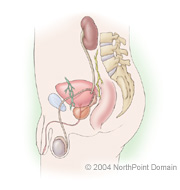Bladder cancer occurs when healthy cells in the bladder start to grow at an unusually fast rate. The increased tissue growth produces masses called tumors, or cancers.
There are three main types of bladder cancer:
-
-
- Transitional cell carcinoma (TCC) arises from the cells that line the bladder and is the most common form.
- Squamous cell carcinoma also comes from the lining cells, but grow differently than TCC.
- Adenocarcinoma, the rarest form, comes from glandular cells in the bladder wall.
WHAT ARE THE SYMPTOMS?
In most cases, bladder cancer has no symptoms in its earliest stages. The following bodily changes may be warning signs::
-
-
- Hematuria, or blood in the urine;
- Frequent urination or a sense of urgency to urinate with no success; and
- Painful or burning sensations during urination.
These symptoms can also result from other conditions such as a bladder infection, a benign (non-cancerous) tumor, kidney disease, bladder stones, or, in men, an enlarged prostate gland.
CAUSES AND RISK FACTORS
The cause of transitional cell carcinoma is unknown, but industrial chemicals and other environmental factors appear to play a significant role.
Risk factors include:
-
-
- Smoking;
- Occupational Exposure, such as arylamines;
- Age between 68 and 69; and
- Male gender and Caucasian or European-American ancestry.
DIAGNOSIS
A cystoscopy is the test most frequently used to diagnose bladder cancer. In a cystoscopy, a physician inserts a telescope-like device into the urethra, which allows the physician to view the inside of the bladder.
TREATMENT APPROACH
Treatment for bladder cancer depends on the type of tumor and the extent to which the cancer has spread. Once a tumor is discovered, patients usually receive an endoscopy-a surgical procedure in which visible areas of tumor are removed. This is done to determine the stage (growth) and grade (level of seriousness) of the tumor.
For superficial tumors, treatment is usually straightforward and centers on either removal of the tumor alone, with frequent monitoring of the bladder, or removal of the tumor combined with intravesical therapy. Intravesical therapy places chemotherapy or immunotherapy drugs in the bladder to minimize or even prevent tumors from recurring.
Deeper tumors require more aggressive treatments. These may include:
-
-
- Cystectomy: Surgical removal of part of the bladder or the entire bladder and its surrounding organs (known as a radical cystectomy).
- Cystoscopic monitoring and intravesical therapy: Placing chemotherapy or immunotherapy drugs in the bladder.
- Radiation therapy: In radiation, high-energy rays prevent cells from growing and dividing.
- Systemic chemotherapy: This form of chemotherapy is taken by mouth or injected, so it travels through the bloodstream to nearly all parts of the body.
LIFESTYLE
Because the major risk factors for bladder cancer are environmental, rather than hereditary, the prospects for preventing this cancer from occurring are promising if the patient:
-
-
- Stops smoking;
- Reduces chemical exposure; and
- Improves nutrition.

